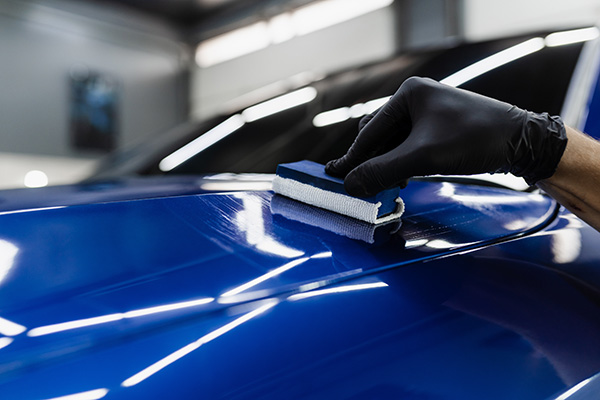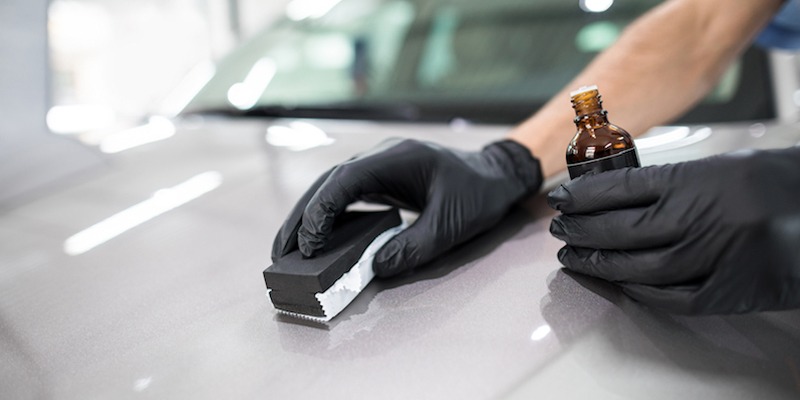The Ultimate Overview to Ceramic Coating: Advantages and Application Methods
The Ultimate Overview to Ceramic Coating: Advantages and Application Methods
Blog Article
Comprehending the Science Behind Ceramic Coating for Improved Car Longevity
The science of ceramic covering is reinventing automobile upkeep by offering an awesome shield against severe environmental aspects. At its core, this innovation takes advantage of the power of silicon dioxide and titanium dioxide to create a sturdy, safety layer. Yet what specifically makes these substances so reliable in guarding a lorry's outside? As we explore the detailed make-up and application procedure of ceramic finishes, we discover the secrets behind their superior protection and long life. Exactly how does this compare to conventional methods, and what effects does it have for automobile maintenance in the long term? The solutions might amaze you.

Structure of Ceramic Coatings
Ceramic finishings are primarily composed of silicon dioxide (SiO2), which is originated from natural products like quartz and sand. This compound develops the foundation of the covering, giving its characteristic solidity and resistance to ecological elements. Along with SiO2, ceramic coverings commonly incorporate titanium dioxide (TiO2) for improved UV defense and increased resistance to environmental pollutants. These nanocomposite materials produce a durable, chemical bond with the vehicle's surface, using a long-lasting safety layer.
The formula of ceramic layers is a meticulous process where the concentration of SiO2 can substantially affect the layer's performance. Higher SiO2 content generally results in greater sturdiness and firmness, adding to the finish's capacity to stand up to scrapes and chemical etching. The equilibrium of components is important; too much SiO2 can make the coating fragile, while too little can endanger its protective residential or commercial properties.
Producers may also integrate extra compounds, such as polysilazane, to improve versatility and simplicity of application. These additives enhance the coating's hydrophobic properties, ensuring water and impurities grain off the surface easily. This engineered composition emphasizes the effectiveness of ceramic finishings in safeguarding a lorry's outside against a selection of negative conditions.
Application Refine Discussed
Using a ceramic finishing to a car entails a number of critical actions, each vital to ensuring ideal attachment and performance of the safety layer - ceramic coating. The process starts with an extensive clean and decontamination of the lorry's surface to get rid of dirt, crud, and previous waxes or sealants. This action is crucial as any kind of contaminants left externally can prevent the finishing's capacity to bond efficiently
Adhering to the initial cleaning, the following action involves brightening the vehicle to eliminate any type of blemishes, such as swirl marks or scratches. Sprucing up makes certain a smooth surface, which is crucial for the layer to adhere appropriately and provide an uniform surface. After brightening, a surface preparation spray is utilized to get rid of any staying deposits and ensure that the surface is entirely tidy.

Safety Benefits
Often hailed for its remarkable safety top qualities, a ceramic finishing provides numerous advantages that considerably enhance automobile sturdiness. At its core, ceramic covering creates a hard, semi-permanent barrier over a vehicle's outside, which serves as a guard view it against numerous environmental threats. This sophisticated layer of protection properly defends against UV rays, oxidation, and fading, preserving the lorry's original paint and luster. It lessens the risks presented by harmful pollutants such as bird droppings, tree sap, and road gunk, which, if left untreated, can cause permanent damages.
Additionally, ceramic coatings display hydrophobic properties, implying they push back water and promote a self-cleaning effect. This characteristic minimizes the adherence of dust and mud, streamlining upkeep and cleansing procedures. The coating's resistance to chemical etching even more makes sure that the automobile's surface area continues to be unblemished regardless of direct exposure to harsh cleaning agents and pollutants.
Along with these protective benefits, the ceramic coating enhances a vehicle's aesthetic appeal by creating a glossy coating that emphasizes shade deepness and quality. This not just maintains the automobile's visual appeal yet additionally adds to its long-lasting value by preserving the her explanation integrity of its outside with time.
Contrasting to Typical Techniques
Unlike standard techniques of car protection, such as shaving or sealers, ceramic finishes provide a more durable and long lasting service. Where waxes and sealants typically give a momentary layer of security, frequently requiring reapplication every couple of months, ceramic finishings form a semi-permanent bond with the lorry's paint. This bond develops a protective layer that is immune to ecological contaminants, UV damages, and minor abrasions.
Traditional waxes are largely composed of all-natural elements like carnauba wax, providing a shiny surface yet lacking the durable protective qualities of ceramic layers. Sealants, while artificial and offering somewhat much better toughness than waxes, still drop short in contrast to the durability and chemical resistance of ceramic coverings. The innovative innovation of ceramic coatings integrates nanotechnology, which allows them to fill out tiny flaws in the paint surface area, resulting in a smoother and extra hydrophobic finish.
In terms of application, ceramic layers need a more careful procedure, frequently demanding professional setup to make certain optimal performance. This contrasts with the reasonably straightforward application of waxes and sealers, which can be applied at home. The superior protection and aesthetic enhancement supplied by ceramic layers justify the investment for those seeking long-lasting automobile conservation.
Long Life and Maintenance
Just how does the durability of ceramic finishings translate right into convenience of maintenance for car owners? The innovative formula of ceramic finishings provides a robust safety layer on the lorry's surface area, which substantially expands the life expectancy of the vehicle's outside finish.
Additionally, the hydrophobic nature of ceramic finishings enables water and various other liquids to grain up and roll off the surface, bring dust and particles with them. While the finishing itself is durable, it is not totally maintenance-free. Therefore, ceramic coatings offer a beneficial equilibrium between long-term durability and streamlined upkeep for vehicle treatment.
Conclusion
Ceramic coverings, with their sophisticated chemical composition of silicon dioxide and titanium dioxide, supply a formidable obstacle against environmental damage, significantly enhancing automobile toughness. When contrasted to traditional approaches, ceramic finishings use exceptional security against UV rays, oxidation, and chemical etching - ceramic coating.
The solution of ceramic finishings is a thorough process where the focus of SiO2 can substantially affect the finish's performance.Applying a ceramic layer to a car involves several crucial actions, each essential to ensuring optimum adhesion and efficiency of the safety layer.Usually hailed for its remarkable protective top qualities, a ceramic finish supplies many benefits that significantly enhance car resilience. The sophisticated solution of ceramic layers offers a robust protective layer on the car's surface, which why not try these out dramatically extends the life-span of the automobile's exterior surface.Ceramic coverings, with their innovative chemical structure of silicon dioxide and titanium dioxide, supply a formidable barrier versus ecological damages, dramatically enhancing automobile sturdiness.
Report this page